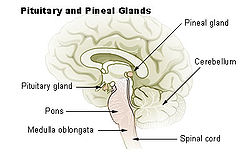The Glands
(Page 2)



The Hypothalamus:
The hypothalamus is one of the more important glands involved in the endocrine system. It has the ability to produce hormones that stimulate or supress hormone release of the pituitary gland (the master gland). Many of the hormones that the hypothalamus releases travel through small arteries to get there. For example, the hypothalamus releases the hormone somatostain, which signals the pituitary gland to stop making growth hormone.
The hypothalamus is one of the more important glands involved in the endocrine system. It has the ability to produce hormones that stimulate or supress hormone release of the pituitary gland (the master gland). Many of the hormones that the hypothalamus releases travel through small arteries to get there. For example, the hypothalamus releases the hormone somatostain, which signals the pituitary gland to stop making growth hormone.
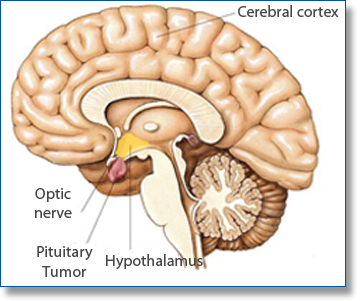
The Adrenals:
The adrenal glands are positioned on top of each kidney and have a triangular shape. They are made up of two parts: the adrenal cortex and the adrenal medulla. The adrenal cortex releases corticosteriods (a type of hormone)that aid in the regulation of the metabolism, salt-water balance in the body, the immune system, and sexual functions. The adrenal medulla secretes catecholamines that help the body adjust to stressful situations (physical and mental) by heightening the blood pressure and increasing the heart rate.
The adrenal glands are positioned on top of each kidney and have a triangular shape. They are made up of two parts: the adrenal cortex and the adrenal medulla. The adrenal cortex releases corticosteriods (a type of hormone)that aid in the regulation of the metabolism, salt-water balance in the body, the immune system, and sexual functions. The adrenal medulla secretes catecholamines that help the body adjust to stressful situations (physical and mental) by heightening the blood pressure and increasing the heart rate.
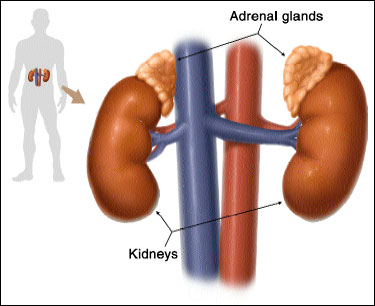
Pancreas:
The pancreas is a long, somewhat hammer-shaped organ located behind the stomach near the back of the abdomen. While speaking of the endocrine system, the pancreas releases the hormones insulin and glucagon, which help control and regulate the sugar levels in the blood.
The pancreas is a long, somewhat hammer-shaped organ located behind the stomach near the back of the abdomen. While speaking of the endocrine system, the pancreas releases the hormones insulin and glucagon, which help control and regulate the sugar levels in the blood.
FUN FACT!
Did you know that the word "endocrine" is derrived from the two Greek words "endon" and "krinein", which mean (respectively) "within" or to "separate"?
Did you know that the word "endocrine" is derrived from the two Greek words "endon" and "krinein", which mean (respectively) "within" or to "separate"?
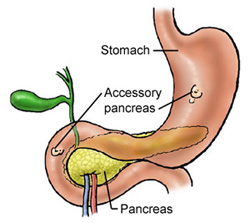
Thymus:
The thymus is vital to the immune systems of children, and it is located in front of the trachea, joined by two lobes. The thymus enlarges until pueberty, and after that, it begins to shrink. It then produces thymosins, hormones that stimulate antibodies to develop. Additionally, the thymus produces white blood cells that fight infections and destroy foreign cells, called T-lymphocytes.
The thymus is vital to the immune systems of children, and it is located in front of the trachea, joined by two lobes. The thymus enlarges until pueberty, and after that, it begins to shrink. It then produces thymosins, hormones that stimulate antibodies to develop. Additionally, the thymus produces white blood cells that fight infections and destroy foreign cells, called T-lymphocytes.
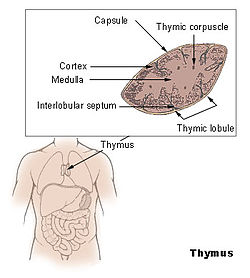
Reproductive
Glands:
The reproductive glands that are involved in the endocrine system are the testes (males) and ovaries (females). These glands produce sex hormones.
Males:
The testes secrete a group of hormones called androgens, which includes testosterone. These hormones are responsible for many male characteristics, such as growth of facial, body, and pubic hair, as well as sperm (gamete) production.
Females:
The ovaries are on both sides of the uterus and produce the hormones estrogen, progesterone, and eggs (female gamete). These hormones control the development of several female characteristics such as breast growth and are involved in the menstrual cycle and pregnancy.
The reproductive glands that are involved in the endocrine system are the testes (males) and ovaries (females). These glands produce sex hormones.
Males:
The testes secrete a group of hormones called androgens, which includes testosterone. These hormones are responsible for many male characteristics, such as growth of facial, body, and pubic hair, as well as sperm (gamete) production.
Females:
The ovaries are on both sides of the uterus and produce the hormones estrogen, progesterone, and eggs (female gamete). These hormones control the development of several female characteristics such as breast growth and are involved in the menstrual cycle and pregnancy.
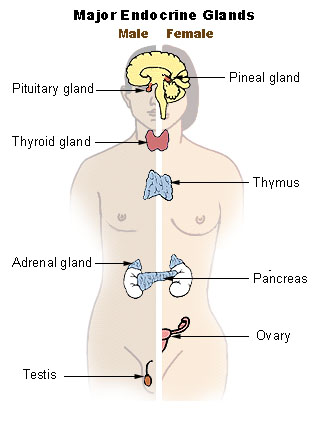
Pineal Body*:
The pineal body is a small gland located in the middle of the brain. The reason its function in the endocrine system is debateable is because it may help regulate the sleep-wake cycle by releasing the hormone melatonin, according to some scientists.
The pineal body is a small gland located in the middle of the brain. The reason its function in the endocrine system is debateable is because it may help regulate the sleep-wake cycle by releasing the hormone melatonin, according to some scientists.
